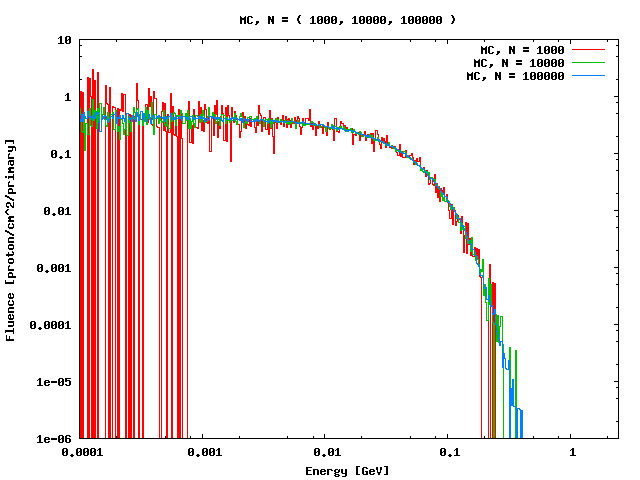Date: Thu, 6 Aug 2015 16:50:23 +0300
On 06.08.2015 12:53, Roman Savinov wrote:
>
> Mikhail,
>
>
> sorry to bother you again but I have a problem with plotting the
> proton fluence of the source. I am trying to recreate results from
> this paper:
>
>
> http://www.sciencedirect.com/science/article/pii/S2214552414000674/pdfft?md5=fa5b5ee5f3679917a4686acc3af31fc7&pid=1-s2.0-S2214552414000674-main.pdf
>
>
> The equation from my first email, f(x) = c10*exp(-(x-c20)/c30) is
> given on pg.81 and describes proton fluence spectra of the August 1972
> Solar Particle Event.
>
> My current goal is to learn how to feed Fluka with that fluence
> spectra and using fluka make a plot of the source fluence (using
> USRBDX maybe?) similar to the one obtained when the function is
> plotted directly and thus validate that fluka gets the right input.
> Right now, plots are not matching and I don't understand why.
>
>
>
>
>
> Also, can you explain why in your source:
>
>
> C minimum in MeV
>
> EMIN1 = C20 - (LOG(EFMIN / C10) * C30)
>
> C maximum in MeV
>
> EMAX1 = C20 - (LOG((EFMAX * GEVMEV) / C10) * C30)
>
>
> the EFMIN and EFMAX are values of min and max energy and not values of
> the function at these two points? I thought you just solved for x in
> the function.
>
> finally, I don't quite understand how would fluka knows that the
> function describes specifically differential fluence and not any other
> parameter that depends on energy.
>
> thank you,
>
> Roman
>
>
>
>
>
Dear Roman,
Yeah, mea culpa.
I see only brutal force way of generating a flux file and then use it as
a spectrum. The PHITS code described in article have a part
[ S o u r c e ]
....
e-type = 6
....
f(x) = c10*exp(-(x-c20)/c30)
p-type = 1
....
which is a differential spectrum dF/dE(i), here is a part from PHITS manual.
e-type = 6, (16)
You can specify the same energy distribution as is the case of
e-type = 5, (15). Unlike e-type = 5, (15), the number of source
particle generated in each bin is the same for all energy bin, but
integrated values of the weight of source particles are adjusted to be
proportional to f (x).
You can also change the number of source particles generated in each bin
by specifing p(i).
p-type = 0, 1
(D=0) generation option
for 0, p(i)=1 for all i is assumed without the following data
for 1, p(i) must be given from the next line by the format as
(p(i),i=1,nm)
Here is my final try, in attachment.
C++ file generating fluence from 0.1 MeV to 2.47 GeV with 2000 bins.
To compile it: g++ -Wall -O2 test_expFlu.cpp -o test_expFluence
To run it: ./test_expFluence
Best regards,
Mikhail
__________________________________________________________________________
You can manage unsubscription from this mailing list at https://www.fluka.org/fluka.php?id=acc_info
- text/plain attachment: flu.dat
- text/x-fortran attachment: source_mod3.f
- application/x-fluka attachment: test-1.inp
- application/x-fluka attachment: test-2.inp
- application/x-fluka attachment: test-3.inp

(image/png attachment: plot02.png)
- application/x-fluka attachment: test.inp
- application/x-flair attachment: test.flair
- text/x-c++src attachment: test_expFlu.cpp